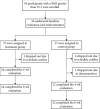The Beneficial Effects of Moxibustion on Overweight Adolescent Girls
- PMID: 34055002
- PMCID: PMC8131142
- DOI: 10.1155/2021/1943181
The Beneficial Effects of Moxibustion on Overweight Adolescent Girls
Abstract
Among adolescent girls, overweight or obesity has both physical and psychological involvement. We conducted a randomized controlled trial of moxibustion using a moxa burner. Fifty-four eligible girls aged 15-18 years with a body mass index (BMI) greater than 25.3 were enrolled in the study. The girls were randomly allocated to the treatment (n = 27) and control (n = 27) groups. The girls underwent treatment three times per week for 8 weeks (24 treatments). Moxibustion was applied to the RN12, RN6, ST25, ST36, and SP6 acupoints. Physical assessments were BMI, waist-to-hip ratio (WHR), and body fat ratio (BFR). Psychological outcomes were measured using the Rosenberg Self-Esteem Scale (RSE). Data were collected at the beginning of the study (baseline), week 4, and week 8. Of the 54 participants, 46 completed the trial. The difference in mean BMI from baseline between the two groups was 0.097 (p=0.655) at week 4 and -0.794 (p=0.001) at week 8. The mean WHR of the treatment group was significantly reduced compared with baseline, with a -0.011 (p=0.017) and -0.035 (p < 0.001) mean change at weeks 4 and 8, respectively. The mean BFR was slightly reduced (-0.253;p=0.474 ) at week 4 compared with baseline in the treatment group. At week 8, it was significantly reduced (-2.068; p < 0.001) from baseline in the treatment group. The mean RSE in the treatment group showed no significant increase from baseline at week 4 (0.155 points, p=0.803), but it improved significantly from baseline at week 8 (1.606 points, p=0.021) compared to that in the control group. No obvious adverse effect was reported during this study. Moxibustion using a moxa burner may be an effective and safe intervention for overweight adolescent girls, having both physical and psychological benefits.
Copyright © 2021 Yuan-Chieh Yeh et al.
Conflict of interest statement
The authors declare no conflicts of interest.
Figures



Similar articles
-
Efficacy of acupuncture and moxibustion therapy for simple obesity in adults: A meta-analysis of randomized controlled trials.Medicine (Baltimore). 2022 Oct 28;101(43):e31148. doi: 10.1097/MD.0000000000031148. Medicine (Baltimore). 2022. PMID: 36316908 Free PMC article.
-
A multi-disciplinary approach to weight management of school-age girls: a study protocol.Pediatr Endocrinol Diabetes Metab. 2021;27(2):76-81. doi: 10.5114/pedm.2021.107162. Pediatr Endocrinol Diabetes Metab. 2021. PMID: 34514764 Free PMC article. Clinical Trial.
-
Moxibustion using different habitat moxa floss for moderate to severe primary knee osteoarthritis: study protocol for a three-armed randomized, double-blinded, sham-controlled trial.Trials. 2018 Jul 27;19(1):403. doi: 10.1186/s13063-018-2794-1. Trials. 2018. PMID: 30053899 Free PMC article.
-
Effects of electroacupuncture on obesity: A systematic review and meta-analysis.Medicine (Baltimore). 2024 Jan 12;103(2):e36774. doi: 10.1097/MD.0000000000036774. Medicine (Baltimore). 2024. PMID: 38215111 Free PMC article.
-
Effect of Moxibustion Combined with Other Interventions on Body Weight Reduction in the Treatment of Obesity: A Systematic Review and Meta-Analysis.J Integr Complement Med. 2024 Jun;30(6):576-587. doi: 10.1089/jicm.2022.0826. Epub 2023 Dec 14. J Integr Complement Med. 2024. PMID: 38099954
Cited by
-
Electroacupuncture relieves type 2 diabetes by regulating gut microbiome.World J Diabetes. 2025 Mar 15;16(3):103032. doi: 10.4239/wjd.v16.i3.103032. World J Diabetes. 2025. PMID: 40093270 Free PMC article.
-
Electroacupuncture at Lower He-Sea and Front-Mu Acupoints Ameliorates Insulin Resistance in Type 2 Diabetes Mellitus by Regulating the Intestinal Flora and Gut Barrier.Diabetes Metab Syndr Obes. 2022 Jul 30;15:2265-2276. doi: 10.2147/DMSO.S374843. eCollection 2022. Diabetes Metab Syndr Obes. 2022. PMID: 35936053 Free PMC article.
-
Effect of Electronic Moxibustion in Patients with IDH: A Randomized Crossover Pilot Study.Int J Gen Med. 2024 Dec 4;17:5793-5805. doi: 10.2147/IJGM.S481418. eCollection 2024. Int J Gen Med. 2024. PMID: 39654985 Free PMC article.
References
-
- Libman I. M., Barinas-Mitchell E., Bartucci A., Chaves-Gnecco D., Robertson R., Arslanian S. Fasting and 2-hour plasma glucose and insulin: relationship with risk factors for cardiovascular disease in overweight nondiabetic children. Diabetes Care. 2010;33(12):2674–2676. doi: 10.2337/dc10-0085. - DOI - PMC - PubMed
LinkOut - more resources
Full Text Sources
Other Literature Sources

